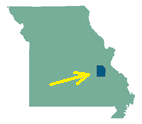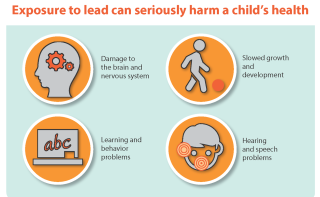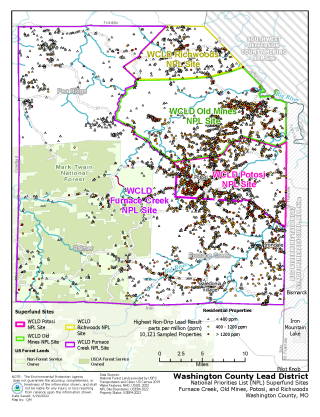Washington County Lead District National Priority List (NPL) Superfund Sites: Furnace Creek, Old Mines, Potosi and Richwoods; Washington County, Missouri – Fact Sheet, June 2022
Site Update: Lead Testing and Cleanup Opportunity
Site Overview and Update

The U.S. Environmental Protection Agency (EPA) Region 7 is remediating (cleaning up) lead-contaminated soil at residential properties within the Washington County Lead District (WCLD) National Priorities List (NPL) Superfund Sites. Lead mine waste was dispersed throughout the area from historic mining activities in the Old Lead Belt in southeastern Missouri. Four NPL sites cover Washington County: Furnace Creek, Old Mines, Potosi, and Richwoods (see two WCLD maps at right below).
Contact EPA Today About Free Testing and Cleanup

If your residential property and/or private well has not been tested (sampled) for lead contamination, this is your opportunity to participate! Please contact EPA (see Contact Information on Page 2) or EPA’s sampling contractor, Tetra Tech, at 573-436-1285.
If your property has already been tested and you have questions about remediation (cleanup), please contact EPA today! Sampling and remediation are performed at no cost to property owners! (See related EPA memorandum.) Residential properties include yards and other child high-use areas such as child care facilities, parks, playgrounds and driveways.
Lead is a toxic metal that is harmful if inhaled or swallowed and can pose serious health risks, particularly to children under 7 years old, as well as pregnant women and nursing mothers.
Children are more vulnerable to lead poisoning than adults because their nervous systems are still developing. Children can be exposed to lead in their environment and before birth from lead in their mother’s body. Children can get lead into their bodies by putting their hands or toys in their mouths after touching lead-contaminated soil and dust. At lower levels of exposure, lead can decrease mental development, especially learning, intelligence, and behavior. Physical growth may also be decreased. A child who swallows large amounts of lead may develop anemia, severe stomachache, muscle weakness, and brain damage. Exposure to lead during pregnancy can also result in premature births. Some effects of lead poisoning in a child may continue into adulthood. (See "What Can I Do?" infographic below.)
Childhood Blood Lead Testing

It is important that children under 7 years old be tested annually, because lead-poisoned children do not always look or act sick. The only way to know if your child has elevated blood lead levels is to have his or her blood tested. Your doctor can do a simple blood test to check you or your child for lead exposure. Talk to your pediatrician, general physician, or local health agency about testing your child. To arrange for lead screening of your children under 7 years old, please contact the Washington County Health Department, 520 Purcell Dr., Potosi, Missouri; phone: 573-438-2164.
Site Background

The WCLD NPL sites are part of the Old Lead Belt in southeastern Missouri, which was one of the world’s largest lead mining districts, where mining began in the early 1700s and produced more than 9 million tons of lead. (See bottom map at right.) Extensive lead and barite mining, milling, and smelting activities were conducted in the WCLD for over 200 years, where contaminated soil, sediment, surface water, and groundwater with elevated levels of heavy metals, primarily lead, prompted the need for state and EPA involvement. Some county residents have unknowingly purchased lead-contaminated soil and/or gravel for use in yards, driveways, parking areas, and playgrounds.
Current Site Status and Next Steps
Residential Yards – To date, EPA has sampled (tested) over 7,300 residential yards for lead levels and over 1,000 yards have been cleaned up under Operable Unit 1 (OU1). Many more properties are eligible for remediation and will be addressed as part of the ongoing remediation efforts. EPA aims to sample and clean up as many eligible residential properties as possible.
Private Drinking Water Wells – Since 2006, over 4,500 private drinking water wells have been tested in Washington County, with approximately one out of seven wells being contaminated with lead and/or other heavy metals. To prevent residents from drinking contaminated well water, EPA supplies water treatment to qualifying residents.

EPA is completing a Remedial Investigation (RI) and Feasibility Study (FS) to address potential lead contamination in private, domestic drinking water wells across the site. (See remedial process diagram at right.)
Once ready, EPA will share the results and the proposed cleanup alternative for groundwater with the community in a Proposed Plan for public comment. EPA will also host a Public Meeting for community input.
EPA wants to help affected communities understand the technical information related to a site. Contact EPA for additional details about technical assistance, such as Technical Assistance Grants.
For updates, contact EPA’s Community Involvement Coordinator to join our email list (see Contact Information below).
For Lead and Site Information
Document collections were developed by EPA to form a clear understanding of the decisions to take actions at a site. Site project information is available to the public at web repositories. Administrative Record (AR) Files and Records of Decisions (RODs) contain technical documents from EPA’s response actions. To view more site information, ARs, RODs, and cleanup documents visit EPA’s Site Profile Pages: Furnace Creek, Old Mines, Potosi, and Richwoods.
If you don’t have internet access, you can view these documents online during normal business hours at the following locations:
EPA Region 7 Records Center
11201 Renner Blvd.
Lenexa, KS 66219
1-800-223-0425
Washington County Public Library
235 E. High St.
Potosi, MO 63664
573 438-4691

For more information about lead, visit:
- EPA's Lead page
- EPA's Learn About Lead page
- EPA's Lead at Superfund Sites page
- EPA's Fight Lead Poisoning With a Healthy Diet page
- EPA’s Protect Your Family From Lead in Your Home
- CDC’s Lead page
- ATSDR ToxFAQs™
Contact Information
Elizabeth Kramer
EPA Community Involvement Coordinator
U.S. EPA Region 7 (ORA/OPA)
11201 Renner Boulevard
Lenexa, KS 66219
Phone: 913-551-7186
Toll-free: 1-800-223-0425
Email: [email protected]

Katy Maynard
EPA Remedial Project Manager
U.S. EPA Region 7 (SEMD/LMSE)
11201 Renner Boulevard
Lenexa, KS 66219
Phone: 913-551-7896
Toll-free: 1-800-223-0425
Email: [email protected]
Steve Sturgess
EPA Remedial Project Manager
U.S. EPA Region 7 (SEMD/LMSE)
11201 Renner Boulevard
Lenexa, KS 66219
Phone: 913-551-7913
Toll-free: 1-800-223-0425
Email: [email protected]
Tetra Tech
EPA’s sampling contractor
573-436-1285
How Will EPA Provide Alternative Water If a Drinking Water Well Is Contaminated?
- An EPA representative will contact you to request that you sign a form agreeing to accept alternative water from EPA. There is no cost to the homeowner.
- An EPA contractor will contact you to arrange a time to install a water treatment unit in your residence.
- The same EPA contractor will periodically provide replacement water filters.
How Will EPA Clean Up My Residential Yard?
If your residential property qualifies for cleanup, EPA will include an access agreement with a sampling results letter. By signing and returning the access agreement, owners are taking the first step in the process to allow the EPA contractor to clean up the affected areas of the yard. This work is being conducted at no cost to the property owner.
Step 1: The EPA contractor will schedule a time to meet with the homeowner, review the affected areas of the yard, answer any questions, and address any concerns.
Step 2: The EPA contractor will ask the owner to sign the checklist and give them final permission to start the work. Once utilities are located, the cleanup can begin within a few weeks, weather permitting. The contractor’s checklist of items to discuss will include the location of private utilities installed by the homeowner at the property and determining the best way to move equipment in and out. It is the sole responsibility of the contractor to have utilities marked and work around them as necessary. If the contractor damages utilities, they will repair the utilities at no cost to the property owner.
Step 3: The cleanup generally includes excavating up to 1 foot of soil from areas that qualify for cleanup, unless it is a garden. If a garden is still above the EPA “action level” at 1 foot of depth, it will be excavated to 2 feet. A highly visible barrier may be placed, if necessary and determined by sampling, prior to backfilling to warn people of contaminated soil below.
Step 4: The EPA contractor will then replace these areas with clean soil, return the grade to the original contours, and restore the lawn. Note: The contractor is only permitted to restore the property to its original condition, and is required to repair or replace any items damaged during the cleanup process.
Step 5: Once the restoration work is complete, the EPA contractor will request a final meeting with you to review the work and sign a final checklist to confirm satisfactory completion.
